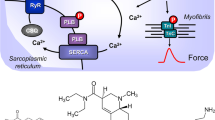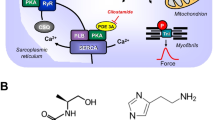Summary
The present study was designed to characterize an “atypical” 5-hydroxytryptamine (5-HT) receptor mediating relaxation of the rat oesophageal tunica muscularis mucosae. All experiments were performed under equilibrium conditions, using pargyline to inhibit the oxidative deamination of indoleamines, and cocaine and corticosterone to inhibit neuronal and extraneuronal uptake. Under these conditions 5-HT (0.3–1000 nmol/l) produced a concentration-dependent relaxation of carbachol-induced tension. The concentration-effect curve to 5-HT was unaffected by potent antagonists for 5-HT1, 5-HT2, 5-HT3 and so called 5-HT1P receptors (metergoline, methysergide, ketanserin, ondansetron, N-acetyl-5-hydroxytryptophyl-5-hydroxytryptophan amide), but was antagonized competitively by ICS 205–930 (pA2 = 6.7). Responses to 5-HT were mimicked by other indoleamines and substituted benzamides with the following order of potency: 5-HT ≥ 5-methoxytryptamine > cisapride = α-methyl-5-HT = (S)-zacopride = renzapride > (RS)-zacopride > 5-carboxamido-tryptamine = metoclopramide = (R)-zacopride > tryptamine > 2-methyl-5-HT. ICS 205–930 afforded similar pA2 values (6.0–6.7) against each agonist, indicating a common site of action. Concentration-effect curves to 5-HT were not affected by tetrodotoxin or indomethacin, sugesting that 5-HT-induced relaxation of the tunica muscularis mucosae was mediated via a postjunctional receptor, independent of endogenous prostanoids. The pharmacological profile of the 5-HT receptor in the rat oesophageal tunica muscularis mucosae correlates well with the 5-HT4 receptor characterized recently in both the CNS and gastro-intestinal tract.
Similar content being viewed by others
References
Akbarali HI, Bieger D, Triggle CR (1986) Tetrodotoxin-sensitive and -insensitive relaxations in the rat oesophageal tunic muscularis mucosae. J Physiol (Lond) 381:49–63
Akbarali H, Bieger D, Triggle CR (1987) Effects of cold storage on relaxation responses in the rat oesophageal tunica muscularis mucosae. Can J Physiol Pharmacol 65:23–29
Arunlakshana O, Schild HO (1959) Some quantitative uses of drug antagonism. Br J Pharmacol Chemother 14:48–58
Bieger D, Triggle C (1985) Pharmacological properties of mechanical responses of the rat oesophageal muscularis mucosae to vagal and field stimulation. Br J Pharmacol 84:93–106
Bockaert J, Sebben M, Dumuis A (1990a) Pharmacological characterization of 5-hydroxytryptamine4 (5-HT4) receptors positively coupled to adenylate cyclase in adult guinea pig hippocampal membranes: effect of substituted benzamide derivatives. Mol Pharmacol 37:408–411
Bockaert J, Sebben M, Dumuis A (1990b) Inter-relationship between the interactions of 5-HT and benzamide derivatives on 5-HT4 receptors in brain (abstract). Second IUPHAR Satellite Meeting on serotonin 64:66
Bradley PB, Engel G, Fenuik W, Fozard JR, Humphrey PPA, Middlemiss DN, Mylecharane EJ, Richardson BP, Saxena PR (1986) Proposals for the classification and nomenclature of functional receptors for 5-hydroxytryptamine. Neuropharmacology 25:563–576
Buchheit KH, Engel G, Mutschler E, Richardson B (1985) Study of the contractile effect of 5-hydroxytryptamine (5-HT) in the isolated longitudinal muscle strip from guinea-pig ileum. Naunyn-Schmiedeberg's Arch Pharmacol 329:36–41
Butler A, Hill JM, Ireland SJ, Jordan CC, Tyers MB (1988) Pharmacological properties of GR38032F, a novel antagonist at 5-HT3 receptors. Br J Pharmacol 94:387–412
Clarke DE, Craig DA, Fozard JR (1989) The 5-HT4 receptor: naughty but nice. Trends Pharmacol Sci 10:385–386
Craig DA, Clarke DE (1989) 5-Hydroxytryptamine and cholinergic mechanisms in guinea pig ileum. Br J Pharmacol 96:247P
Craig DA, Clarke DE (1990) Pharmacological characterisation of a neuronal receptor for 5-hydroxytryptamine in guinea pig ileum with properties similar to the 5-hydroxytryptamine4 receptor. J Pharmacol Exp Ther 252:1378–1386
Craig DA, Eglen RM, Walsh LKM, Perkins LA, Whiting RL, Clarke DE (1990) 5-Methoxytryptamine and 2-methyl-5-hydroxytryptamine-induced desensitization as a discriminative tool for the 5-HT3 and putative 5-HT4 receptors in the guinea pig ileum. Naunyn-Schmiedeberg's Arch Pharmacol 342:9–16
Davis WG (1976) A dual action of 5-hydroxytryptamine on the ovarian suspensory ligament of the rat. J Pharm Pharmacol 28:502–504
Dumuis A, Bouhelal R, Sebben M, Croy R, Bockaert J (1988a) A nonclassical 5-hydroxytryptamine receptor positively coupled with adenylate cyclase in the central nervous system. Mol Pharmacol 34:880–887
Dumuis A, Bouhelal R, Sebben M, Bockaert J (1988b) A 5-HT receptor in the central nervous system, positively coupled with adenylate cyclase, is antagonized by ICS 205–930. Eur J Pharmacol 146:187–188
Dumuis A, Sebben M, Bockaert J (1989a) BRL 24924: a potent agonist at a non-classical 5-HT receptor positively coupled with adenylate cyclase in colliculi neurones. Eur J Pharmacol 162:381–384
Dumuis A, Sebben M, Bockaert J (1989b) The gastrointestinal prokinetic benzamide derivatives are agonists at the non-classical 5-HT receptor (5-HT4) positively coupled to adenylate cyclase in neurones. Naunyn-Schmiedeberg's Arch Pharmacol 340:403–410
Eglen RM, Swank SR, Walsh LK, Whiting RL (1990) Characterisation of 5-HT3 and atypical 5-HT receptors mediating guinea-pig ileal contractions in vitro. Br J Pharmacol 101:513–520
Elswood CJ, Bunce KT, Humphrey PPA (1990) Identification of 5-HT4 receptors in guinea pig ascending colon (abstract). The second IUPHAR satellite meeting on serotonin P86:78
Fozard JR, Mobarok Ali ATM, Newgrosh G (1979) Blockade of serotonin receptors on autonomic neurones by (−)-cocaine and some related compounds. Eur J Pharmacol 59:195–210
Fukuda S, Su C, Lee JF (1986) Mechanisms of extraneuronal serotonin uptake in the rat aorta. J Pharmacol Exp Ther 239:264–269
Furchgott RE (1972) The classification of adrenoceptors (adrenergic receptors). An evaluation from the standpoint of receptor theory. In: Handbook of experimental pharmacology. Springer, Berlin Heidelberg New York 33:283–335
Hill JM, Bunce KT, Humphrey PPA (1990) Investigation of the neuronal “non-5-HT3” receptor mediating contraction of guinea-pig ileum. Br J Pharmacol 99:182P
Hoyer D (1985) Functional correlates of serotonin 5-HT1 recognition sites. J Recept Res 8:59–81
Humphrey PPA (1984) Peripheral 5-hydroxytryptamine receptors and their classification. Neuropharmacology 23:1503–1510
Humphrey PPA, Fenuik W, Watts AD (1983) Pre-junctional effects of 5-hydroxytryptamine on noradrenergic nerves in the cardiovascular system. Fed Proc 42:218–222
Kao CY (1966) Tetrodotoxin, saxitoxin and their significance in the study of excitation phenomena. Pharmacol Rev 18:997–1049
Kaumann AJ (1990) Piglet sinoatrial 5-HT receptors resemble human atrial 5-HT4-like receptors. Naunyn-Schmiedeberg's Arch Pharmacol 342:619–622
Kaumann AJ, Sanders L, Brown AM, Murray KJ, Brown MJ (1990a) Human atrial 5-HT receptors: similarity to rodent neuronal 5-HT4 receptors. Br J Pharmacol C17
Kaumann AJ, Sanders L, Brown AM, Murray KJ, Brown MJ (1990b) A 5-hydroxytryptamine receptor in human atrium. Br J Pharmacol 100:879–885
Leff P, Martin GR (1988) The classification of 5-hydroxytryptamine receptors. Med Res Rev 8:187–202
Mawe GM, Branchek TA, Gershon MD (1986) Peripheral neural serotonin receptors: identification and characterization with speck antagonists and agonists. Proc Natl Acad Sci USA 83:9799–9803
Paiva MQ, Caramona M, Osswald W (1984) Intra- and extra-neuronal metabolism of 5-hydroxytryptamine in the isolated saphenous vein of the dog. Naunyn-Schmiedeberg's Arch Pharmacol 325:62–68
Parker RB, Waud DR (1971) Pharmacological estimation of drug receptor dissociation constants. Statistical evaluation: I. Agonists. J Pharmacol Exp Ther 177:1–12
Reeves J, Brunce KT, Humphrey PPA, Gunning SJ (1989) Further characterisation of the 5-HT receptor mediating smooth muscle relaxation in rat oesophagus. Br J Pharmacol 98:800P
Richardson BP, Engel G, Donatsch P, Stadler PA (1985) Identification of serotonin M-receptor subtypes and their specific blockade by a new class of drugs. Nature 316:126–131
Sanger GJ, King FD (1988) From metoclopramide to selective gut motility stimulants and 5-HT3 receptor antagonists. In: Drug design and delivery. Harwood Academic Publishers New York 3:273–295
Scholtysik G, Imoto Y, Yatani A, Brown AM (1988) 5-Hydroxytryptamine antagonist ICS 205–930 blocks cardiac potassium, sodium and calcium currents. J Pharmacol Exp Ther 245:773–778
Schuurkes JAJ, Van Neuten JM, Van Daele HG, Reyntjens AJ, Janssen PAJ (1985) Motor stimulating properties of cisapride on isolated gastrointestinal preparations of the guinea pig. J Pharmacol Exp Ther 234:775–783
Shenker A, Maayani S, Weinstein H, Green JP (1987) Pharmacological characterization of two 5-hydroxytryptamine receptors coupled to adenylate cyclase in guinea pig hippocampal membranes. Mol Pharmacol 31:357–367
Takaki M, Mawe GM, Barasgh J, Gershon MD (1985) Physiological responses of guinea pig myenteric neurones secondary to the release of endogenous serotonin by tryptamine. Neuroscience 16:223–240
Thoa NB, Eccleston D, Axelrod J (1969) The accumulation of 14C-serotonin in the guinea pig vas deferens. J Pharmacol Exp Ther 169:68–73
Triggle CR, Ohia SE, Bieger D (1988) 5-hydroxytryptamine-induced relaxation of rat and mouse oesophageal smooth muscle. Pharmacologist 30:A126
Verbeuren TJ, Jordaens FH, Herman AG (1983) Accumulation and release of [3H]-5-hydroxytryptamine in saphenous veins and cerebral arteris of the dog. J Pharmacol Exp Ther 226:579–588
Villalón CM, den Boer MO, Heiligers J PC, Saxena PR (1990) Mediation of 5-hydroxytryptamine-induced tachycardia in the pig by the putative 5-HT4 receptor. Br J Pharmacol 100:665–667
Author information
Authors and Affiliations
Additional information
Send offprint requests to D. E. Clarke at the above address
Rights and permissions
About this article
Cite this article
Baxter, G.S., Craig, D.A. & Clarke, D.E. 5-Hydroxytryptamine4 receptors mediate relaxation of the rat oesophageal tunica muscularis mucosae. Naunyn-Schmiedeberg's Arch Pharmacol 343, 439–446 (1991). https://doi.org/10.1007/BF00169544
Received:
Accepted:
Issue Date:
DOI: https://doi.org/10.1007/BF00169544




